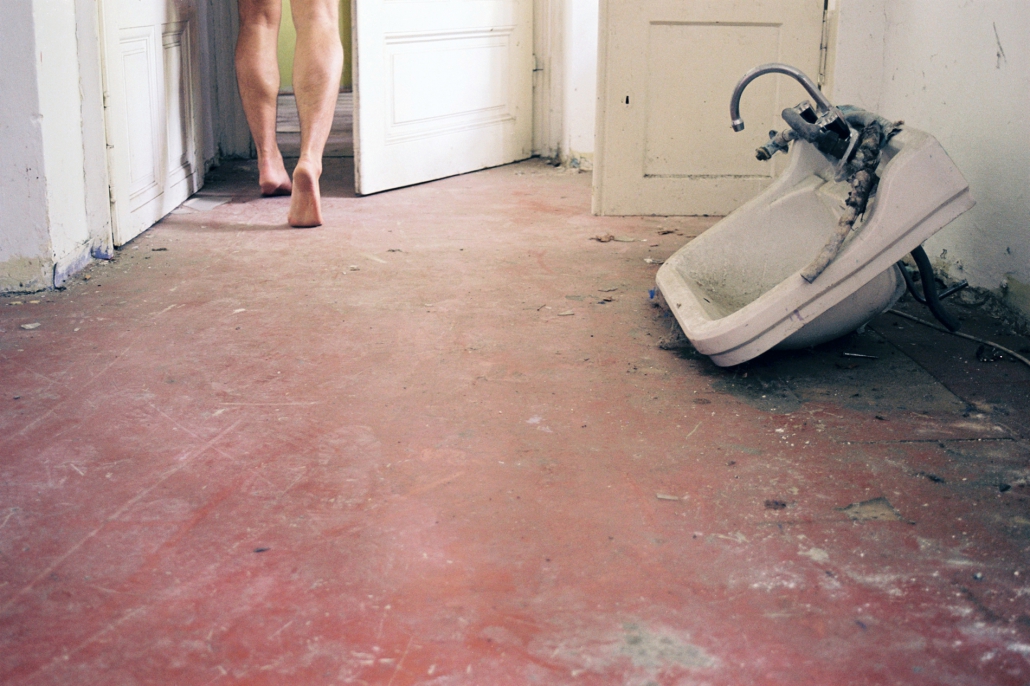WALTER MOSER | In Search Of Traces. Marko Zink’s “Kornhäusl” Series
Color flaking from walls, floors covered with dirt and birds’ feathers, open doors directing the viewer’s attention towards two naked feet – the nearly empty rooms of the former villa Kornhäusl in Vienna’s district of Ottakring, which Marko Zink photographed for his picture series of the same name (“Kornhäusl,” 2004), have obviously stood vacant for a long time. The derelict objects he found on site are the only traces of its one-time occupants. Newspapers, a child’s spinning top, or a washbasin broken from the wall suggest an abandoned architecture on the verge of fading away – it was actually razed to the ground two days after these pictures were taken.
Zink’s photos are not aimed at providing an “objective” inventory of these rooms. Rather, they are subjected to the photographer’s lens and his subjective perspective, resulting in the creation of a photographic space that is defined primarily by the depiction of floors and partial views through open doors. Zink uses these floors as a stage on which he lets a male person walk through ramshackle rooms.
The photographer leaves us in the dark as to who this person really is, only portions of the (male) body are shown. The two feet depicted at the pictures’ edges evoke the impression that they are about to leave the space of the image and disappear into an “off space,” which is to say into a space outside the photograph. Thus, the protagonist of these images is both present and absent.
This ambivalence between presence and absence draws attention to a theme Marko Zink has explored in other works as well. For instance, in his photo series “Tragödien” (“Tragedies,” 2008 – 2010) and “Im Wald” (“In the Forest,” since 2004) he not only lets his protagonists disappear behind animal masks, but also, spatially, behind trees. This equivocal photographic play with the presence and absence of the pictured persons brings an ambiguity to the fore that is continued in the staging of the image’s contents:
As with “Tragödien” and “Im Wald,” the characteristic quality of the setup of the “Kornhäusl” series results from its rendition of a real space that is used for fictitious photographic staging.
Tangible architecture is combined with the protagonist’s posture. This playful arrangement involving real space and photographic fiction and, thus, also the transparency and surface of the photograph results from a photographic arrangement that serves the construction of the picture’s specific narrative content:
According to his own account, during his visit to the villa in Ottakring Marko Zink came across newspapers from the time of the National Socialist regime in which the one-time occupants had marked homosexual contact ads. This illustrates the tragic constellation in which he lets the performer poses before the camera.
This protagonist, however, does not enact a scene proper, which is to say no causal linear narrative is conveyed; rather, the said narrative is symbolized. All the photos of the “Kornhäusl” series intentionally show naked male legs, with a heel conspicuously visible to the viewer. The heel, which has served as a symbol of (male) vulnerability since Achilles, thus epitomizes the conflict between homosexual identity of the original occupant and its denial by society during the National Socialist dictatorship.
This pictorial semantics is repeated in variations with the photographic rendition of different rooms. Thus, across several pictures, the format of the photo series gives viewers the impression of walking through dilapidated architectural structures. The anonymous “visitor” to the villa disappears not only from the pictures but often also through a door separating one room from the next. As the camera’s focus is set to the floors of these rooms and primarily depicts the performer traversing them in doorways that open up a view into the adjacent room, a destabilization of these spaces ensues, which suggests to the viewer a temporal sequence.
Zink’s photographs, however, convey temporality not only through sequences of movements, the temporal aspect of these images also points us to the photographic concept of the trace.
Of course, by depicting abandoned objects, photographs such as those of the “Kornhäusl” series can not only document traces, they themselves can be traces as well.
The famous metaphor of the photograph as a footprint – which is caused by touch and contact just as the exposure of the photographic image results from light falling onto a negative – is depicted in the “Kornhäusl” series in the true sense of the word.
A photograph is an imprint of something that has long ceased to exist. It is a vestige of a referent that has vanished. In these images, however, it is not only the villa that has disappeared by now but also its one-time occupant and his personal history, which is nevertheless portrayed and preserved in a photographic image. In this dialectic between things past and their continuing presence lies the significance of the photograph as memory. Photography creates objects that touch off a process of recollection in the viewer’s mind.
With Marko Zink, photographically capturing these dwindling traces also means staging them. His mix of photographic documentarism and visual fiction involves a photographic dialectics that proves pivotal to the “Kornhäusl” series: These photographs not only contain a transparent image of a real villa and an opaque picture of a photographic narrative, they also show something that is absent and nevertheless present, signify a visually fixated moment and lasting duration, convey the evanescent and its traces, try to come to terms with things past and present as well as with memories of the forgotten.
PUBLICATION
→ CATALOGUE | Blinde Flecken | Luftschacht publishing house (sold out)


